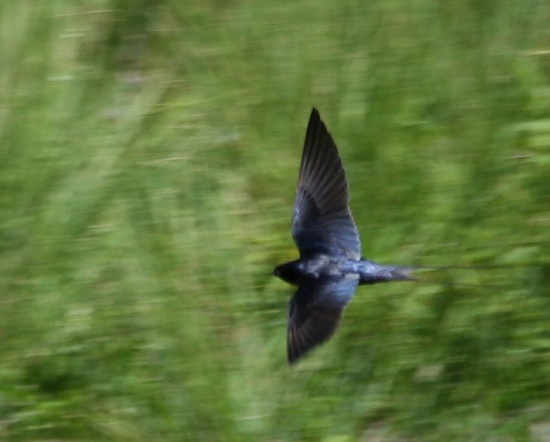Alternative name: Blue Swallow
- Hirundo atrocaerulea
Identification
Length 18-25 cm
Male: A dark metallic-blue swallow (appears black in poor light) with very long outer tail feathers.
Female: Similar to the male, but with a shorter tail.
Distribution
An intra-African migrant. Breeds in highland grasslands in eastern South Africa, western eSwatini, western Zimbabwe and adjacent Mozambique, Malawi, north-eastern Zambia, south-western Tanzania, and south-eastern Democratic Republic of Congo.
It visits north-eastern Democratic Republic of Congo, southern Uganda and western Kenya in the southern winter[3].
Taxonomy
This is a monotypic species[1].
Subspecies lynesi is not recognised by most authorities[2].
Habitat
Grasslands in areas of high rainfall. Classified as Vulnerable in the 2007 IUCN Red List, due to the limited range and the threat of habitat loss (BirdLife International, 2007). The species is approaching extinction in South Africa and Swaziland, largely as a result of commercial afforestation in areas that were previously grassland.
Behaviour
Diet
The diet includes insects caught aerially.
Breeding
It builds a cup-shaped nest from mud and grass, lined with fine grass, animal hair and feathers. The 3 white eggs are incubated by the female for 14 days; the young fledge approximately 22 days later.
References
- Clements, JF. 2009. The Clements Checklist of Birds of the World. 6th ed., with updates to December 2009. Ithaca: Cornell Univ. Press. ISBN 978-0801445019.
- Avibase
- BirdLife International (2007) Species factsheet: Hirundo atrocaerulea. Downloaded from http://www.birdlife.org on 25/10/2007.
- ARKive
Recommended Citation
- BirdForum Opus contributors. (2025) Montane Blue Swallow. In: BirdForum, the forum for wild birds and birding. Retrieved 13 May 2025 from https://www.birdforum.net/opus/Montane_Blue_Swallow




